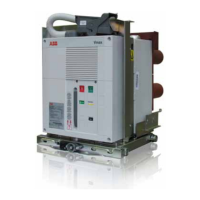37
THE INTERNAL SHIELD OF
A VACUUM INTERRUPTER
CAN ACQUIRE AN ELECTRIC
CHARGE WHICH CAN BE
RETAINED EVEN AFTER THE
VOLTAGE IS REMOVED.
DISCHARGE THE MID-BAND
RING WITH A GROUNDING
STICK BEFORE WORKING ON
ANY PART OF THE CIRCUIT-
BREAKER.
DANCER
To verify the integrity of the vacuum interrupters perform the
following low-frequency withstand voltage test:
1. Open the circuit-breaker (no control power supplied to the
circuit-breaker).
a. Connect the high potential lead to one terminal.
b. Ground the remaining 5 terminals and circuit-breaker
frame.
Workers must stand back at least 1.5 metres.
2. Start machine with output potential at 0 (zero) VAC.
3. Increase the potential to the required voltage (see Table 3).
4. Hold for one minute.
5. Decrease potential to 0 (zero) and turn off machine.
6. Repeat for the remaining 5 terminals.
A successful withstand indicates satisfactory vacuum integrity.
Replace interrupters that fail to sustain the voltage across the
open contacts.
Testing MUST be done with an AC source only.
DC testing is not considered a valid test for vacuum integrity.
Testing with meggers or other similar devices is not
considered valid under any circumstances.
5.3.3. Application of the X-ray
Emission standards
One of the physical properties of vacuum insulation is the
possibility of X-ray emission when the interrupter contacts are
open.
The specific tests carried out at the PTB laboratories
(Physikalisch-Technische Bundesanstalt, in Brunswick -
Germany) show that local emission at a distance of 10 cm
from the interrupter or pole surface, does not exceed 1
mSv/h.
It follows that:
– at the rated service voltage the use of vacuum interrupters
is absolutely safe;
– application of the withstand voltage at power frequency,
according to the IEEE C37.4 Standards, is safe;
– application of a voltage higher than the withstand voltage
at power frequency or of a direct current test voltage,
specified in the IEEE C37.4 Standards, cannot be used;
– limitation of the above-mentioned local phenomena, with
interrupters with open contacts, depends on keeping the
specific distance between the contacts.
This condition is intrinsically guaranteed by correct
operation of the drive and by adjustments of the
transmission system.

